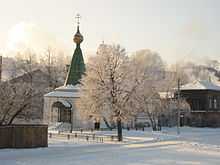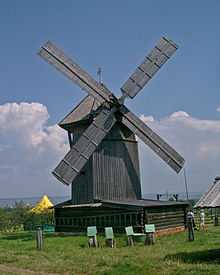Kozmodemyansk, Mari El Republic
| Kozmodemyansk (English) Козьмодемьянск (Russian) Цикмӓ (Hill Mari) Чыкма (Meadow Mari) Чикме (Chuvash) | |
|---|---|
| - Town[1] - | |
|
| |
.svg.png) Location of the Mari El Republic in Russia | |
 Kozmodemyansk | |
|
| |
_(2005).png) |
|
|
| |
| Administrative status (as of December 2013) | |
| Country | Russia |
| Federal subject | Mari El Republic[2] |
| Administratively subordinated to | town of republic significance of Kozmodemyansk[2] |
| Administrative center of | town of republic significance of Kozmodemyansk,[1] Gornomariysky District[1] |
| Municipal status (as of December 2013) | |
| Urban okrug | Kozmodemyansk Urban Okrug[3] |
| Administrative center of | Kozmodemyansk Urban Okrug[3] |
| Statistics | |
| Population (2010 Census) | 21,257 inhabitants[4] |
| Time zone | MSK (UTC+03:00)[5] |
| Founded | 1583 |
| Postal code(s)[6] | 425350, 425352–425355 |
|
| |
| Kozmodemyansk on WikiCommons | |
Kozmodemyansk (Russian: Козьмодемья́нск; Hill Mari: Цикмӓ, Tsikmä; Meadow Mari: Чыкма, Čykma) is a town in the Mari El Republic, Russia, located at the confluence of the Vetluga and the Volga Rivers. Population: 21,257 (2010 Census);[4] 22,771 (2002 Census);[7] 24,746 (1989 Census).[8]
History
Though not attested in any document, the town of Kozmodemyansk was likely preceded by a Mari wooden fortress controlling the confluence of the Volga and the Vetluga Rivers. It was also an important resting and trading place for traders from the North who traveled along the river to Volga Bulgaria. The Mongol invasion of Volga Bulgaria was a serious blow to the region.
Kozmodemyansk was founded by Tsar Ivan the Terrible in 1583 after his conquest of Kazan in 1552 and the Cheremis Wars in 1553-1557, 1582, and 1592 as a frontier fortress to guard the new border of the Grand Duchy of Moscow. The fortress was named after Sts. Cosmas and Damian. For many years the streltsy fortress, of which a sole tower from 1697 subsists, was the only building in the area.

As commerce along the Volga developed, a town gradually grew around the fortress, but the region remained largely populated by the Mari people. The town had a fair specializing in wooden and wicker ware goods produced by local craftsmen. The town was very active during summer, but winters brought a halt to river traffic.
In the 19th century, Kozmodemyansk was a more important trading place along the Volga than the neighboring towns of Vasilsursk and Cheboksary. It was a typical halfway "overnight" stop for the Volga River steamers between Nizhny Novgorod and Kazan. In the 20th century, the town developed industrially. According to the official Imperial Russian statistics, on January 1 (14), 1913, the population was 5,500, of which 97.5% were Russians.
In 1918, there was a dispute between Mari and Chuvash representatives of Kozmodemyansk in the Idel-Ural Movement. It was not decided to which proposed state (Mariland or Chuvashia) the town, as well as the surrounding countryside, should be merged. A few rare mentions which have remained show that the Volga was to become the border between Chuvashia and Mariland, with considerable cultural and political autonomy (after the example of the status of the Grand Duchy of Finland in the Russian Empire) given to the Hill Mari minority on the south side of the Volga in Chuvashia (according to the preserved papers from the Meeting of Representatives of the Minority Peoples on May 15, 1917 and Idel-Ural State].
Administrative and municipal status
Within the framework of administrative divisions, Kozmodemyansk serves as the administrative center of Gornomariysky District, even though it is not a part of it.[1] As an administrative division, it is incorporated separately as the town of republic significance of Kozmodemyansk—an administrative unit with the status equal to that of the districts.[2] As a municipal division, the town of republic significance of Kozmodemyansk is incorporated as Kozmodemyansk Urban Okrug.[3]
Museums

A local museum was opened in 1919 and now contains paintings by many Mari and Russian artists. A regional museum to preserve artifacts of the Mari culture was opened in 1979. An open-air ethnographic museum opened in 1983. It contains over sixty varied buildings typical of Russian/Mari culture. They house over 2,000 exhibits of artisan craft and tools. Even the variety of fences around the grounds display typical Mari designs.
References
Notes
- ↑ 1.0 1.1 1.2 1.3 Resolution #9
- ↑ 2.0 2.1 2.2 Law #22-Z
- ↑ 3.0 3.1 3.2 Law #15-Z
- ↑ 4.0 4.1 Russian Federal State Statistics Service (2011). "Всероссийская перепись населения 2010 года. Том 1" [2010 All-Russian Population Census, vol. 1]. Всероссийская перепись населения 2010 года (2010 All-Russia Population Census) (in Russian). Federal State Statistics Service. Retrieved June 29, 2012.
- ↑ Правительство Российской Федерации. Федеральный закон №107-ФЗ от 3 июня 2011 г. «Об исчислении времени», в ред. Федерального закона №248-ФЗ от 21 июля 2014 г. «О внесении изменений в Федеральный закон "Об исчислении времени"». Вступил в силу по истечении шестидесяти дней после дня официального опубликования (6 августа 2011 г.). Опубликован: "Российская газета", №120, 6 июня 2011 г. (Government of the Russian Federation. Federal Law #107-FZ of June 31, 2011 On Calculating Time, as amended by the Federal Law #248-FZ of July 21, 2014 On Amending Federal Law "On Calculating Time". Effective as of after sixty days following the day of the official publication.).
- ↑ Почта России. Информационно-вычислительный центр ОАСУ РПО. (Russian Post). Поиск объектов почтовой связи (Postal Objects Search) (Russian)
- ↑ Russian Federal State Statistics Service (May 21, 2004). "Численность населения России, субъектов Российской Федерации в составе федеральных округов, районов, городских поселений, сельских населённых пунктов – районных центров и сельских населённых пунктов с населением 3 тысячи и более человек" [Population of Russia, Its Federal Districts, Federal Subjects, Districts, Urban Localities, Rural Localities—Administrative Centers, and Rural Localities with Population of Over 3,000] (XLS). Всероссийская перепись населения 2002 года [All-Russia Population Census of 2002] (in Russian). Retrieved August 9, 2014.
- ↑ Demoscope Weekly (1989). "Всесоюзная перепись населения 1989 г. Численность наличного населения союзных и автономных республик, автономных областей и округов, краёв, областей, районов, городских поселений и сёл-райцентров" [All Union Population Census of 1989: Present Population of Union and Autonomous Republics, Autonomous Oblasts and Okrugs, Krais, Oblasts, Districts, Urban Settlements, and Villages Serving as District Administrative Centers]. Всесоюзная перепись населения 1989 года[All-Union Population Census of 1989] (in Russian). Институт демографии Национального исследовательского университета: Высшая школа экономики [Institute of Demography at the National Research University: Higher School of Economics]. Retrieved August 9, 2014.
Sources
- Государственное Собрание Республики Марий Эл. Закон №22-З от 3 мая 2006 г. «О порядке решения вопросов административно-территориального устройства (деления) Республики Марий Эл», в ред. Закона №50-З от 31 октября 2014 г. «О внесении изменений в некоторые законодательные акты Республики Марий Эл». Вступил в силу со дня официального опубликования. Опубликован: "Марийская правда", №81, 6 мая 2006 г. (State Assembly of the Mari El Republic. Law #22-Z of May 3, 2006 On the Procedures of the Administrative-Territorial Structure (Division) of the Mari El Republic, as amended by the Law #50-Z of October 31, 2014 On Amending Various Legislative Acts of the Mari El Republic. Effective as of the official publication date.).
- Правительство Республики Марий Эл. Постановление №9 от 18 января 2008 г. «О реестре административно-территориального устройства Республики Марий Эл», в ред. Постановления №555 от 24 октября 2014 г. «О внесении изменения в Постановление Правительства Республики Марий Эл от 18 января 2008 г. №9». Опубликован: "Собрание законодательства Республики Марий Эл", №2, ст. 108, 26 февраля 2008 г. (Government of the Mari El Republic. Resolution #9 of January 18, 2008 On the Registry of the Administrative-Territorial Structure of the Mari El Republic, as amended by the Resolution #555 of October 24, 2014 On Amending Resolution #9 by the Government of the Mari El Republic of January 18, 2008. ).
- Государственный Совет Республики Марий Эл. Закон №15-З от 18 июня 2004 г. «О статусе, границах и составе муниципальных районов, городских округов в Республике Марий Эл», в ред. Закона №50-З от 31 октября 2014 г. «О внесении изменений в некоторые законодательные акты Республики Марий Эл». Вступил в силу через 10 дней после официального опубликования. Опубликован: "Марийская правда", №116, 24 июня 2004 г. (State Council of the Mari El Republic. Law #15-Z of June 18, 2004 On the Status, Borders, and Composition of the Municipal Districts, Urban Okrugs in the Mari El Republic, as amended by the Law #50-Z of October 31, 2014 On Amending Various Legislative Acts of the Mari El Republic. Effective as of after 10 days after the official publication.).
External links
- Official website of Kozmodemyansk (Russian)
- Unofficial website of Kozmodemyansk (Russian)
| ||||||||||||||||||||